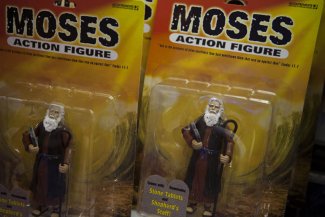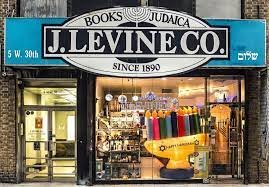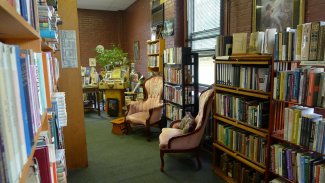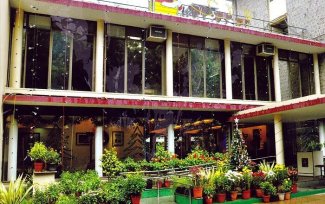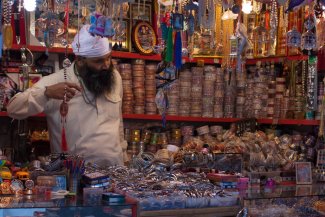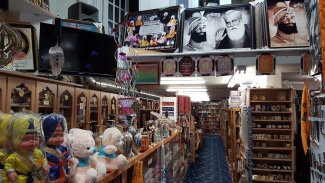This essay is a revised version of one written some years ago. The Big Apple – New York City’s Manhattan – now has a brand new gurduara; I think it is the first community space for Sikhs in the city. My regret is that, having spent many decades in it, it happened after I moved out of the city.
Just two blocks from it stands a musty old building, with its best days behind it, with the modest logo: J. Levine Co. 1890, Judaica.
I entered and a whole new world opened.
Years ago, the New York Times (November 25, 1991) noted: “J. Levine & Company is not the typical old-fashioned religious bookstore. The showroom has marbled floors, polished chrome and glass cases with blue neon trim. On display are hand-painted mezuzahs, Batman and Ninja Turtle yarmulkes, and gold and silver menorahs.”
It’s a place where they still love books. Arts Judaica for all your Jewish needs. Danny Levine, the fourth-generation scion of the family now manages this richly embellished labor of love that claims to house the world’s largest collection of Judaic books and paraphernalia.
"I've found that people are looking today for presentation or atmosphere," said the owner. “His sales,” he said, “had doubled over the last three years and went up 10 percent in one year.” The store also carries religious articles and furniture for synagogues and operates a successful mail-order service. Apparently, diversification has made the store recession-proof.
The store is chock full of books on a variety of topics from the Jewish perspective. Themes range the gamut, from serious theology and cook books to gay and lesbian Jew, to intermarriage in Soviet Jewry, humor and photography. A new book on or about Judaism or Jewish life is published every month or less.
The many “Christian Book & Gift” shops that dot the landscape of this country and continent are the Christian counterparts to J. Levine, the place for the Jewish world of arts.
Walk into any Christian book store; the kindness and smiles of the staff will overwhelm you. Piped in music greets you and soothes the soul; the aura instantaneously awakens the senses and transports you into a different universe with pleasant aromas that waft in to welcome you.
What better greeting for a visitor?
There are books and religious gift-items galore. Everything is tastefully displayed such that even “window shopping” becomes both pleasant and instructive. The plethora of medallions and artifacts can become preachy but one can find books on the variety of human experience and issues that confront us in life – from drug addiction, psychosocial and sexual issues to bioethical concerns or the history and interpretation of Christian doctrines like the import of Crucifixion. The staff is most helpful and knowledgeable. I briefly encountered such lasting ruminations not so long ago.
Now for a very different experience. Amidst a brutal winter, I was in India at a conference for a week. At my request the sponsors arranged my stay in the YMCA – right in the shadow of the historic Bangla Sahib Gurduara in Delhi. I wanted the proximity of the gurduara to be refreshing, energizing and available; Bangla sahib was barely a five-minute walk from the Y.
What caught me was the stark contrast in energy, attitude and worldview exemplified by the two adjoining centers – the Christian YMCA and the Sikh Gurduara Bangla Sahib. Keep in mind that my observations are a few years old.
Half a dozen YMCA or YWCA buildings abut the entrance to Bangla Sahib. Every Christian edifice displayed huge, larger than life billboards that you couldn’t miss if you tried. They advertised services – from the religious with cake and bake sales (I was there during the Xmas season) to books and lessons in sewing for women, ESL (English as a second language) classes, tutorials in mathematics and science, driving lessons and instruction in tennis, golf, swimming and self-defense; even computer skills could be learned for a nominal sum. Signs touted a safe modestly priced residence for single working women, irrespective of religion, caught in the din and hyper-madness of the big city.
And the books, both fiction and non-fiction, ranged from poetry to cooking and, of course, a large choice on or about Christianity; they were not just modestly priced but cheap, like 3 or 4 for a hundred Rupees — about two for a dollar.
Who wouldn’t be attracted? To get customers a business has to first catch and hold the eye; religion is no different. And then the seller works on building loyalty and repeat business.
In contrast, Bangla Sahib had a special strongbox on display and a larger-than-life sign to solicit donations for gold plating of the building. True, that this may have been there only for a few weeks or so. There were billboards nearby within the gurduara premises – for prayer services at various deraas or other gurduaras for warding off evil spirits and bad omens. Heaven only knows what they have to do with Sikhi.
There were a few private business stalls just outside the gurduara perimeter hawking CD’s of hymns, breviaries (gutkas), patkas, kirpans, karras and other paraphernalia of a Sikh life. The space was small and crowded, the merchandize not attractively or openly displayed but piled on top of each other – only the sales staff could handle it; they alone knew where to find something. One had to know exactly what to want and ask for; there was no room to sit or browse. It is as if “window shopping” is an alien idea. User friendly these stalls are not.
As large and rich as it is Bangla Sahib has no bookshop in or near it but another massive historical gurduara nearby – Rakabganj -- does. So, I trekked out to that. It’s also the headquarters of the Delhi Gurduara Management Committee -- an eye-catching, expensively constructed monument fashioned largely in marble and granite.
No signs directed me to the bookshop which is in the basement and reached via a wide swirling and majestic marble staircase. I don’t know the amount of space allocated to the book shop in square feet but it is beyond impressive.
Books were stacked in one huge hall in several spacious aisles. But the lighting was so dim that reading seemed both difficult and unwelcome. Books were in cloth-wrapped bundles with a couple of copies from each bundle sitting atop of each package. I failed to detect any order to their display – by author, title or topic. One would be lucky to find something one is looking for.
In summary, the bookshop was housed in a poorly lit basement, with no cataloging. Pick a book and stroll around and you just won’t remember where to put it back or pick another copy.
Only one man seemed to know where any and every book could be found, and that is a credit to his phenomenal memory and dedication. But pity the poor visitor if he saw a book somewhere and now wanted to revisit that area again.
On content I would rate the shop near a ten on a scale from one to ten but in being user friendly I would be falling off the chart on the other end.
I wish this bookshop was in a busy public space where Sikhs and Non-Sikhs congregate or travel about and, even more importantly, if it could become user friendly in presentation and organization. To start even minimal cataloguing and signage, a few comfortable chairs and good lighting would do wonders.
There is no functioning lending library in Bangla Sahib, Rakabganj or any other gurduara anywhere in this wide world that I know of. Dear readers, before you take umbrage at my angst keep in mind that the operative idea here is “functioning lending library.”
Parenthetically, I have to add that both these historic gurduaras do have a functioning and busy medical clinic. I also heard of a multi-million dollars plan for a huge state of the art medical facility near Rakabganj. I celebrate this much needed facility in today’s India.
North America boasts of over 200 gurduaras but I have yet to see one with a functioning library or a book shop. Yes, many gurduaras have a collection of books that remain uncatalogued and behind closed doors inaccessible to everyone except for an hour or two on Sundays. In time, most books slowly but surely disappear. And I wonder who selects the books; there appears to be little thinking directing their acquisition.
I am aware of only one facility that I would dub half-way decent book shop for Sikh literature and artifacts in North America and that is the Sacha Sauda in downtown Toronto – not attached physically to any gurduara.
Once again, because it has many books and other paraphernalia – the contents rate an “A” but not always the presentation. In user friendliness it pales. One has to cover one’s head to walk in and remove one’s shoes, even though it is a bookshop and not a gurduara.
Because of its location it can and does attract people off the street as any shop should — mostly Sikhs but a fair number of non-Sikhs, too. Unfortunately, its organization and lay out does not encourage the casual and the curious to walk in and just thumb through what is available. Window shopping is not the norm. Sacha Sauda, our one-of-a-kind book shop in North America, like J. Levine, has a healthy mail order business as well.
Mind you, and I want to emphasize this, with Sacha Sauda we have come a long way forward. It’s just that we have a longer way to go. My brief negative notations about it here are not meant to disparage or diminish it but to propel it further forward.
Keep in mind that just about every town in North America has a Christian bookstore. Also, don’t forget that every two-bit town in this country has a secular book shop, and a lending library; practically all of them have a section on religion where Christian and Jewish literature is easily found. One can also find a book or two on Hinduism and Islam, with a growing collection on Buddhism, but it is as if Sikhism doesn’t even exist.
The story of most public libraries is similar. They may stock a few books on Sikhism that are mostly dated or poor representations of Sikhi. We have, at times, undertaken to donate and deliver collections of often poorly chosen books to libraries. They were gratefully accepted and then a year or two later, junked Why? Simply because they were taking valuable shelf space and showed no evidence of usage. No one ever took them out. Frankly our community does not make for habitual readers.
Considering that in my house books seem to grow like crab grass I should have heeded the dubious axiom that “books like friends should be few and well chosen.” But I never have. Ergo, I thirst for the Minerva Book Shop in Shimla, India that whetted my appetite for books over 60 years ago, and sometimes I think longingly of the musty smells of the Strand in New York City that boasts of eight miles of books.
My mind went to a pithy and brief comment by Danny Levine, the manager of the 121 years old J. Levine Company with which I started this column today: "I want the store to be the Henri Bendel of Judaica," he said. "People should feel, wow, this is Judaism at its best."
What a wonderful idea!
Exactly as I envision how Sacha Sauda and the Rakabgunj Book Shop might be transformed with a bit of imagination and a modicum of effort – and soon. And then may they clone rapidly all over the world.
But should we not be working on awakening the love of books first? And where does that start except in a family and school? And secular schools are not going to encourage the reading of and about Sikhi, nor should we expect them to.
The easiest way to teach the love of reading is to show that you have that love of reading within you. The most difficult, almost impossible, task is to try to teach what one does not know, does not do, or does not value.
Forget not, words come in books and that Sikhi is a way of life for which the Word is the eternal living Guru.


